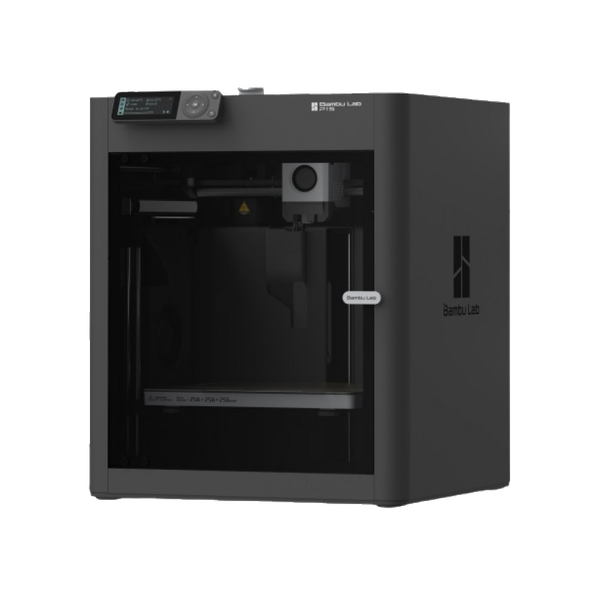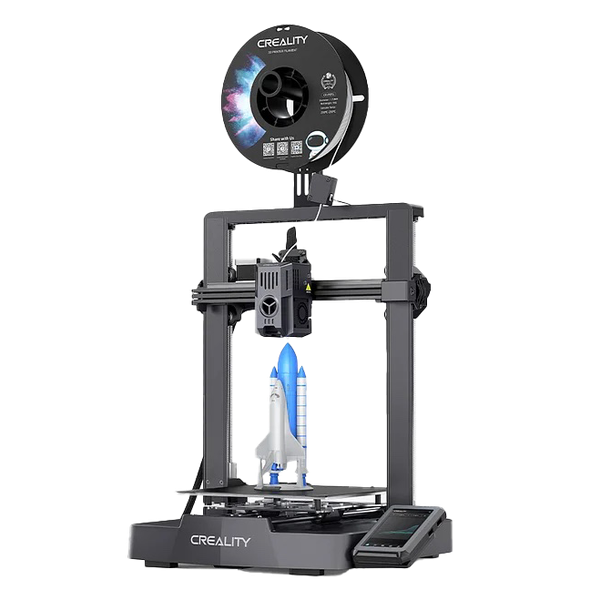If you make a purchase using a shopping link on our site, we may earn a commission. Learn More
Comparing the Bambu Lab P1S and Creality Ender 3 V3 KE

Bambu Lab P1S
(~10.25 x 10.25 x 10.25 in)
Vs.

Creality Ender 3 V3 KE
(~8.75 x 8.75 x 9.5 in)
About the Bambu Lab P1S
The Bambu Lab P1S is an upgraded version of the Bambu Lab P1P, adding an integrated enclosure with a see-through glass door, along with an air filter and additional fans to aid in part cooling and build chamber temperature management. These features allow the P1S to more effectively print temperature-sensitive filament types such as ABS and ASA. The P1S offers high-speed 3D printing in a robust CoreXY design with a print volume of 256 x 256 x 256 mm (10" x 10" x 10"). It includes a direct drive extruder with an all-metal hot end capable of heating up to 300°C, enabling it to use all 3D printing filament types including PLA, PETG, TPU, ABS, ASA, and more. The P1S includes firmware features such as vibration compensation and pressure advance to maintain print quality at speeds of up to 500 mm/s. Although it lacks the Lidar sensor and AI camera features of the Bambu Lab X1-Carbon, the P1S does include an automatic bed leveling system as well as an integrated camera for monitoring prints. The display on the P1S is a monochrome text-only display with a button controller, which is unusually limited for its price point. However, it also includes WiFi and can be controlled using the Bambu Studio computer application or Bambu Handy smartphone app, giving users the ability to monitor and control the printer remotely. Files can be loaded over WiFi or using a microSD card. The downside to the P1S is that repair parts are only available from the manufacturer, meaning you will need to trust Bambu Lab to continue to support the hardware and software of the P1S over the lifetime of the machine. Fortunately, Bambu Lab does offer a wide selection of repair parts on their site. Our overall take on the Bambu Lab P1S is that it's a compelling choice for users who want a capable 3D printer that doesn't require assembly or extensive calibration. In many ways, this is the same printer as the popular Bambu Lab P1P, but with the added enclosure and air filter. Those features aren't critical for 3D printing, but give the P1S added capability to print more materials as well as reducing noise and smell during printing. We've seen many users upgrade the P1P with an enclosure, so it's likely worth it to pay the added price for the P1S. However, the P1S is limited in a few ways--it doesn't have as many ease-of-use features as the X1-Carbon, and its proprietary hardware and firmare mean you are reliant on Bambu Lab for continued support of the machine. For users who want a 3D printer that feels high-end but want to stay within a budget, the Bambu Lab P1S is an excellent choice.
About the Creality Ender 3 V3 KE
The Creality Ender 3 V3 KE is a 3D printer that was released in 2023. It is an upgraded version of the Ender 3 V3 SE, offering more premium features at a slightly higher price point. One of its standout features is the upgraded Sprite direct drive extruder, which has an all-metal hotend and a more powerful heater core. This allows for more filament throughput at high print speeds and provides more options for different printing materials. The printer also includes CR-touch auto bed leveling, which ensures perfect first layers and reduces issues with bed adhesion. The addition of linear rails on the X and Y axis, as well as dual Z axis leadscrews, provides added stability to the moving parts of the printer, allowing for higher printing speeds without sacrificing quality. The Creality Ender 3 V3 KE also comes with a touch screen and advanced firmware, making it easier to navigate the interface and configure 3D printing settings. Overall, the Creality Ender 3 V3 KE offers a good printing experience at a relatively low price point. It is shipped with most of the parts pre-assembled, requiring minimal assembly and setup. The printer's direct drive extruder and auto bed leveling system contribute to smoother and more reliable printing. The inclusion of linear rails and dual Z axis leadscrews further enhance the stability and precision of the printer's motion system. While it may lack some premium features found in more expensive models, such as wireless capabilities, the Creality Ender 3 V3 KE still provides a solid performance for its price. It is worth noting that the printer features a PEI Spring Steel bed, which offers excellent first layer adhesion without the need for additional treatments. However, periodic cleaning with a solvent is required to maintain the bed's adhesion. Overall, the Creality Ender 3 V3 KE is a reliable and affordable option for 3D printing enthusiasts.
Click here to view the Bambu Lab P1S on the Bambu Lab website.
Click here to view the Creality Ender 3 V3 KE on Amazon.
You can find a side-by-side comparison of the specifications for these two printers in the table below:
Details & Specifications
Bambu Lab P1S
Creality Ender 3 V3 KE
General
Extruder & Hot-end
Physical Characteristics
Usability
Electronics
Where to Buy
Brands Overview
Bambu Lab
Bambu Lab, based in Shenzhen, China, and founded by five ex-DJI engineers, has made notable strides in the 3D printing arena with their unique combination of innovation and user-friendly interfaces. They launched their journey with a successful Kickstarter campaign in 2022, securing over $7 million in funding. Their printer lineup, from the flagship Bambu X1-Carbon to the more affordable Bambu P1P, showcases their commitment to high-performance features while ensuring ease of use, making them a rising competitor in the 3D printing industry.
Creality
Creality is the largest manufacturer of consumer 3D printers, and is a well-known brand in the 3D printing industry, offering a range of printers for various budgets and needs. Creality, based in Shenzhen, China, was founded in 2014. Their initial product was the CR-3, followed by the CR-10 in 2017 with a much larger build volume than anything else in the same price range. The Creality Ender 3, released in 2019, greatly expanded the market for low cost 3D printers. Creality has an extensive lineup of 3D printers, covering budget, midrange, premium, and professional categories. Their cost-effective approach includes using off-the-shelf components, open design, shipping printers in kit form, and aluminum extrusions for frames and gantries. Creality offers so many options that it can be overwhelming to choose between all of the available models, so its important to have an understanding of what features are important to you when shopping for a Creality 3D printer.